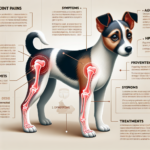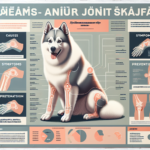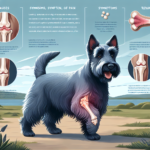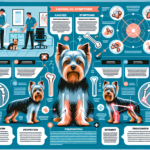Toy Fox Terrier Joint Pain: Causes, Symptoms, Prevention, and Treatment

Introduction
The Toy Fox Terrier is a small, energetic breed known for its intelligence, agility, and affectionate nature. Originating in the United States, this breed was developed in the early 20th century by crossing Smooth Fox Terriers with various toy breeds, such as the Manchester Terrier and Chihuahua. The result is a compact, spirited dog that excels in both companionship and various dog sports.
While the Toy Fox Terrier is generally a healthy breed, it is not immune to certain health issues. Common concerns include patellar luxation, Legg-Calvé-Perthes disease, and various eye conditions. Among these, joint pain is a significant issue that can affect the quality of life for these active little dogs.
Joint health is particularly crucial for the Toy Fox Terrier due to their high energy levels and agility. Maintaining healthy joints ensures that these dogs can continue to enjoy their active lifestyles without pain or discomfort.
Breed-Specific Joint Pain Risks
Genetic Predisposition
The Toy Fox Terrier is genetically predisposed to several joint-related issues. Patellar luxation, a condition where the kneecap dislocates from its normal position, is particularly common in this breed. This condition can lead to arthritis and chronic pain if not addressed promptly. Additionally, some Toy Fox Terriers may be prone to Legg-Calvé-Perthes disease, a condition that affects the hip joint and can lead to severe arthritis.
Age-Related Risks
As Toy Fox Terriers age, they become more susceptible to joint pain and related issues. Arthritis is a common age-related condition that can affect this breed, leading to stiffness, pain, and reduced mobility. Owners should be particularly vigilant as their dogs approach middle age, typically around 5-7 years old, to catch any early signs of joint deterioration.
Activity Level and Joint Stress
Toy Fox Terriers are known for their high energy levels and love for physical activities such as running, jumping, and playing. While regular exercise is essential for their overall health, excessive or inappropriate activities can put undue stress on their joints. Owners should be mindful of the types of activities their dogs engage in to prevent joint injuries and long-term damage.
Common Symptoms of Joint Pain in Toy Fox Terriers
General Symptoms
- Limping or favoring one leg
- Stiffness, especially after rest
- Reluctance to jump or climb stairs
- Decreased activity levels
- Whining or yelping when moving
- Swelling around the joints
Breed-Specific Symptoms
In Toy Fox Terriers, symptoms of joint pain may manifest more subtly due to their small size and high pain tolerance. Owners should watch for changes in behavior, such as increased irritability or reluctance to engage in previously enjoyed activities. Additionally, any signs of patellar luxation, such as a sudden “skipping” gait, should be taken seriously.
When to Consult a Vet
If you notice any of the above symptoms in your Toy Fox Terrier, it is crucial to consult a veterinarian promptly. Early diagnosis and treatment can significantly improve the prognosis and quality of life for your dog. Regular veterinary check-ups are also essential for monitoring joint health and catching any issues early.
Preventive Measures for Joint Health
Exercise Recommendations
Regular, moderate exercise is vital for maintaining joint health in Toy Fox Terriers. Activities such as short walks, gentle play sessions, and low-impact exercises like swimming can help keep their joints flexible and strong. Avoid high-impact activities like excessive jumping or running on hard surfaces, as these can exacerbate joint stress.
Dietary Suggestions
A balanced diet rich in essential nutrients is crucial for joint health. Consider incorporating foods or supplements that contain glucosamine, chondroitin, and omega-3 fatty acids, which are known to support joint function. Consult your veterinarian for specific dietary recommendations tailored to your dog’s needs.
Weight Management
Maintaining a healthy weight is one of the most effective ways to reduce joint stress in Toy Fox Terriers. Obesity can exacerbate joint pain and lead to other health issues. Monitor your dog’s weight regularly and adjust their diet and exercise routine as needed to keep them at an optimal weight.
Early Screening and Monitoring
Regular veterinary check-ups and early screening for joint issues can help catch problems before they become severe. Your veterinarian may recommend specific tests, such as X-rays or joint fluid analysis, to assess your dog’s joint health. Early intervention can significantly improve outcomes and prevent long-term damage.
Treatment Options for Joint Pain
Non-Surgical Treatments
For mild to moderate joint pain, non-surgical treatments can be highly effective. These may include:
- Medications: Non-steroidal anti-inflammatory drugs (NSAIDs) can help reduce pain and inflammation. Your veterinarian may also prescribe pain relievers or joint supplements.
- Physical Therapy: Exercises and therapies designed to improve joint function and reduce pain can be beneficial. Hydrotherapy, in particular, is excellent for low-impact exercise.
- Lifestyle Adjustments: Modifying your dog’s daily routine to include more rest and low-impact activities can help manage joint pain.
Surgical Options
In severe cases, surgical intervention may be necessary to alleviate joint pain. Common surgical options for Toy Fox Terriers include:
- Patellar Luxation Surgery: This procedure realigns the kneecap to prevent dislocation and reduce pain.
- Hip Surgery: For dogs with severe hip dysplasia or Legg-Calvé-Perthes disease, surgical options such as femoral head ostectomy (FHO) or total hip replacement may be considered.
Alternative Therapies
Alternative treatments can complement traditional therapies and provide additional relief for joint pain. These may include:
- Acupuncture: This ancient practice can help reduce pain and improve joint function.
- Hydrotherapy: Water-based exercises are excellent for low-impact joint strengthening.
- Massage: Regular massage can help improve circulation and reduce muscle tension around the joints.
Lifestyle and Management Tips
Daily Care Routine
A consistent daily care routine can help manage and alleviate joint pain in Toy Fox Terriers. This may include:
- Short, frequent walks to keep joints flexible
- Gentle play sessions to maintain muscle strength
- Regular grooming to monitor for any changes in mobility or pain
- Administering any prescribed medications or supplements
Modifying the Home Environment
Making your home more comfortable for a dog with joint pain can significantly improve their quality of life. Consider the following modifications:
- Installing ramps to help your dog navigate stairs or get onto furniture
- Providing orthopedic beds for better joint support
- Using non-slip mats to prevent falls on slippery surfaces
Long-Term Management
Long-term management of joint pain involves a combination of regular veterinary care, appropriate exercise, and a balanced diet. Consistent monitoring and adjustments to your dog’s routine can help keep them active and happy despite joint pain.
FAQs About Toy Fox Terriers and Joint Pain
What are the early signs of joint pain in Toy Fox Terriers?
Early signs of joint pain include limping, stiffness, reluctance to jump or climb stairs, and decreased activity levels. If you notice any of these symptoms, consult your veterinarian promptly.
Can joint pain in Toy Fox Terriers be prevented?
While it may not be possible to prevent all cases of joint pain, maintaining a healthy weight, providing appropriate exercise, and regular veterinary check-ups can significantly reduce the risk.
Are there specific foods that can help with joint health?
Yes, foods rich in glucosamine, chondroitin, and omega-3 fatty acids can support joint health. Consult your veterinarian for specific dietary recommendations tailored to your dog’s needs.
When should I consider surgery for my dog’s joint pain?
Surgery is typically considered when non-surgical treatments are no longer effective, and the dog’s quality of life is significantly impacted. Your veterinarian can help determine the best course of action based on your dog’s specific condition.
Conclusion
Joint pain is a significant concern for Toy Fox Terriers, but with proper care and attention, it can be managed effectively. By understanding the causes, symptoms, and preventive measures, owners can help ensure their dogs maintain healthy joints and enjoy an active, pain-free life. Regular veterinary check-ups, a balanced diet, appropriate exercise, and early intervention are key to maintaining joint health in this energetic and affectionate breed.
Remember, your veterinarian is your best resource for advice and treatment options tailored to your dog’s specific needs. By working together, you can help your Toy Fox Terrier live a long, healthy, and happy life.



